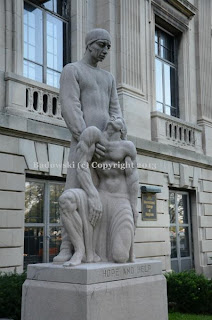The Crusader: Victor Lawson
Monument, 1931
Lorado Taft
East central section
Graceland Cemetery
4001 North Clark Street
Although Lorado Taft was educated in the Beaux Arts style
and remained conservative in his approach through most of his career, this monument
signals a slight shift in that he moves away from classicizing tendencies and
complex compositions to a simpler approach to the human form, emphasizing its
sheer bulk and smooth surfaces. A 10-foot high medieval knight wearing cloak
and mail, featuring the cross of a crusader on his shield, the figure
commemorates the “crusading” career of Victor Fremont Lawson, publisher of the
politically independent Chicago Daily
News from 1876 until his death in 1925. Lawson was a pioneer in the
practice of sending reporters to distant locations to find news and he
established a chain of correspondents that became the Daily News Foreign
Service.
Visitors to the site will notice that the grave and
monument are unmarked, reflecting Lawson’s tendency to make anonymous donations
to a variety of charitable causes. The impact of the work is accentuated by the
surrounding landscape, replanted during the 1990s as part of the cemetery’s
ongoing effort to recapture the design of earlier years, particularly the style
of O. C. Simonds. He served as cemetery superintendent during the 1880s and
1890s and continued on as landscape consultant for many years.
Other works:
- George Washington—Robert Morris—Haym Salomon Monument
- Eternal Silence: Dexter Graves Monument
- Fountain of the Great Lakes
- Fountain of Time



